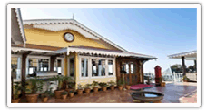|
|
|
| |
| |
Travel destination in India, Ajmer |
|
|
| |
Ajmer :
Area : 55.67 sq km.
Language : Rajasthani, Hindi, Urdu, English, Sindhi
Rainfall : 38 to 51 cms.
STD Code : 0145. |
About Ajmer
Ajmer - Situated in the heart of Rajasthan and south west of Jaipur, the state capital, Ajmer is a blooming city with an excellent amalgam of Sufi culture and Hindu religion. Lying on the shores of Ana Sagar and flanked by barren hills, Ajmer is situated in a valley and is a major crowd puller for being a city of unique charm and fascination.
Ajmer was founded by Ajaipal Chauhan in 7th century, who built a hill fort and named it Ajaimeru (that is invincible hill). For being strategically located in a valley and bounded by the Aravallis, the town is geographically a protected area and hence, since centuries, the Rajputs, the Mughals and the Marathas desired for this city. Ajmer became the seat of administration for the Chauhans in the 12th century till Prithviraj was defeated in 1193 AD by Mohammad Ghauri. It was then, that Ajmer became a part of the Delhi Sultanate and remained so till 1326. However, Rana Kumbha of Mewar and Raja Maldeo again established Rajput rule over Ajmer.
CLIMATE
Temperatures are very high during summers and very low during winters. Ajmer has a typical desert type of climate. The best season to visit this place is between October and March. Following the temperature, light tropical clothes are ideal in summers, and if the mercury dips too low then you might require heavy woolens in winter.
FORTS & PLACES TO VISIT IN AJMER
• Ajmer-e-Sharief Dargah : At the foot of a barren hill, lies the major tourists hub of Ajmer - the Ajmer-e-Sharief-Dargah. India’s most venerated pilgrimage center for people from all faiths, the Dargah houses the tomb of the Sufi Saint - Khwaja Muin-ud-din Chisti. Popularly known as Khawaja Saheb or Khawaja Sharief or Dargah Sharief, the shrine here is next only to Mecca or Medina for the Muslims of South Asia. Emperor Akbar used to make a pilgrimage to this Dargah from Agra once a year.
• Ana Sagar Lake : Built by Anaji between 1135-1150 AD, the Ana Sagara Lake was created bydamming the river Luni. This artificial lake is bounded by hills and on its bank is a beautiful park - the Dault Bagh, making this place one fine spot for strolling in the morning and evening. The Daulat Bagh Gardens were laid by another Mughal Emperor - Jehangir. The 'Baradari', the marble pavilion was raised by Mughal Emperor Shahjahan in 1637. This lake is located towards the north of Ajmer city and is one major source of water in the city. You can hire jetty, paddle boats at the lake every day between 9am & 5pm. You have to pay a nominale amout for this.
• Taragarh Fort : At a distance of 3kms and one hour climb beyond the Adhai din ka Jhonpra mosque is the Taragarh Fort, built in the 7th century by Ajaipal Chauhan, Ajmer's founder. The Taragarh Fort or the Star Fort, gives a panoramic view of the city. The Fort situated on a hill is easily accessible by cars and you have to take winding bridle path to reach it. The Mughals used this fort as the site of military activities and Britishers used its as a sanatorium.
• Akbar's Palace (Government Museum) : Constructed by Akbar in 1570, the Royal palace of Akbar in reed sandstone was converted into a Government Museum and today it houses a rich collection of Mughal and Rajput armoury. Very close to the main post office, the museum displays some of the fine and delicate sculptures of the region. The building laid down in a square pattern giving it a fabulous look showcases collection from 8th century AD, which include - old weapons, miniature paintings, ancient rock inscriptions and stone sculptures. The museum is open everyday except Friday between 10am & 4.30pm.
• Dargah of Khawaja Moin-Ud-Din- Chisti : This is the shrine of Khawaja Moin-ud-din-Chisti, a medieval sufi saint who came to India from Persia in 1192. Humayun completed the construction of the shrine and the gate was added by the Nizam of Hyderabad. The saint's tomb is in the center of the second court. The actual tomb is concealed in raised marble dome by a silver platform.
|
|
|
| |
|
|
|







